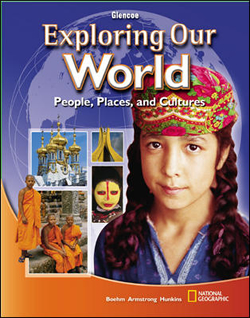Exploring Our World: People, Places, and CulturesChapter 13:
Physical Geography of RussiaWeb Activity Lesson Plans"Siberia and Global Warming" Introduction
In this chapter, students learned about the cold and barren region of Russia known as Siberia. In previous chapters, students read about the issue of global warming and its possible effects on the world’s climate. As described at the Web site, scientists today are studying the permafrost layer—a layer of permanently frozen soil below the surface—in Siberia. As temperatures in the area increase, possibly due to global warming, the permafrost is melting. The melting of the layer could release high levels of the gas methane, which may have a much more damaging effect on the climate than carbon dioxide. Lesson Description
Students will examine an article that describes research on global warming and the release of greenhouse gases in Siberia. After they read the article, students will answer several questions and create a diagram that shows the relationship between rising temperatures and conditions in the region of Siberia. Before students begin, discuss what they have learned about the land and climate of Siberia. Instructional Objectives - The student will be able to describe the physical geography of the region of Russia known as Siberia and explain what permafrost is.
- The student will recognize the connection between the rising temperatures thought to be related to global warming and the release of greenhouse gases in the unique geography of Siberia.
Student Web Activity Answers - Methane is being released from bubbles frozen in Siberian lakes; materials here have been frozen in the permafrost since the last Ice Age.
- a unique type of permafrost found in Siberia
- If thawing continues as predicted in models, large amounts of methane will be released from the thawed yedoma, perhaps leading to more climate warming. This source of greenhouse gases has not been included in models for future climate warming.
- Scientists walk across the frozen lakes to map locations of bubbles trapped in the ice. They then use traps to get daily measurements of the methane released by the bubbles.
- Students’ diagrams should correctly demonstrate the cyclical relationship between climate warming and the thawing of Siberian permafrost, which in turn releases more greenhouse gases (methane) and may lead to continued climate warming.
 | 




